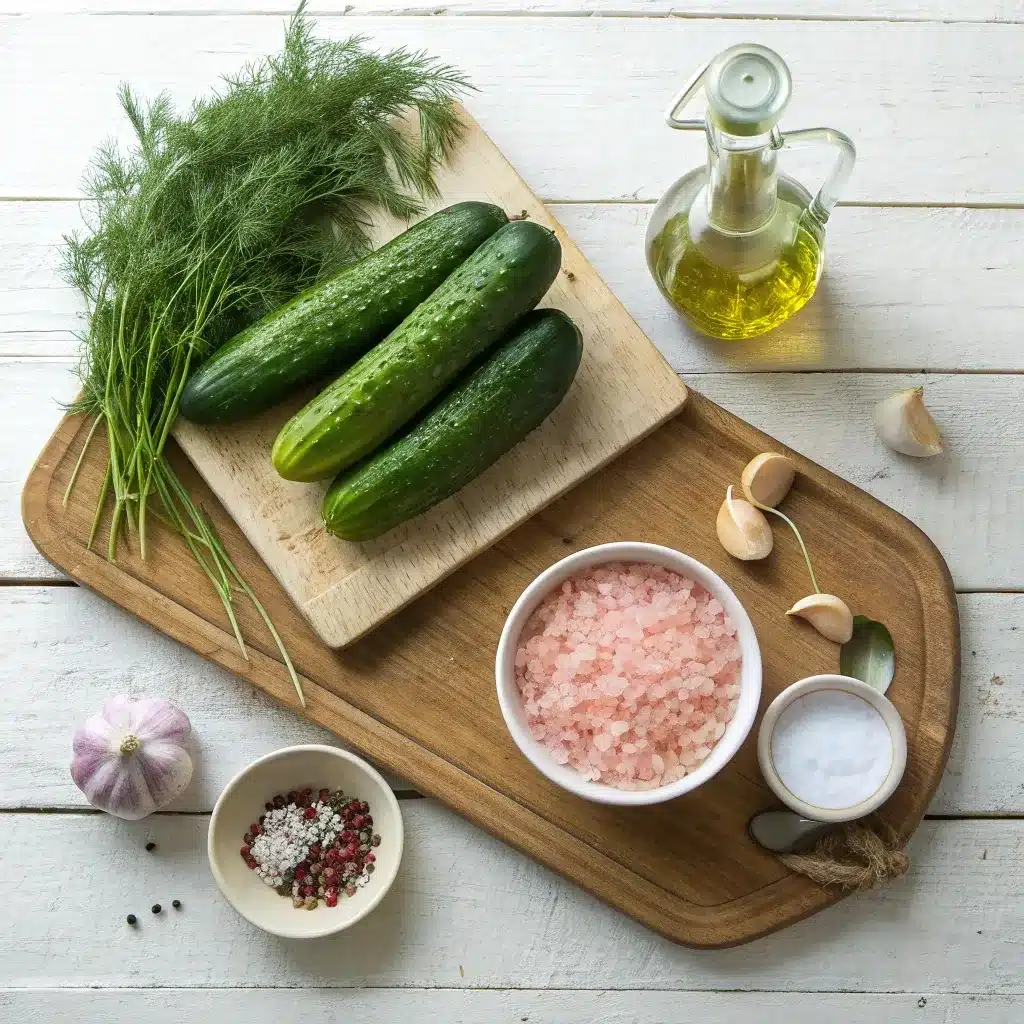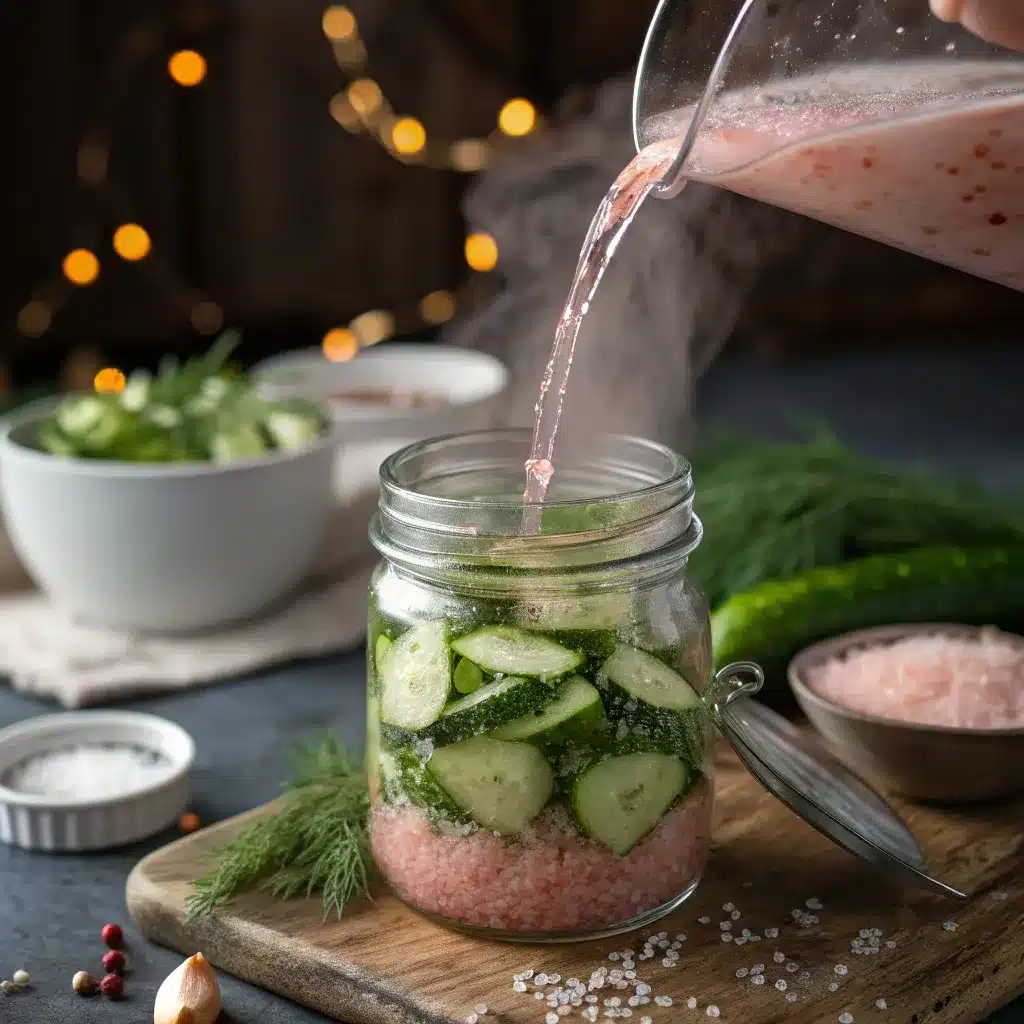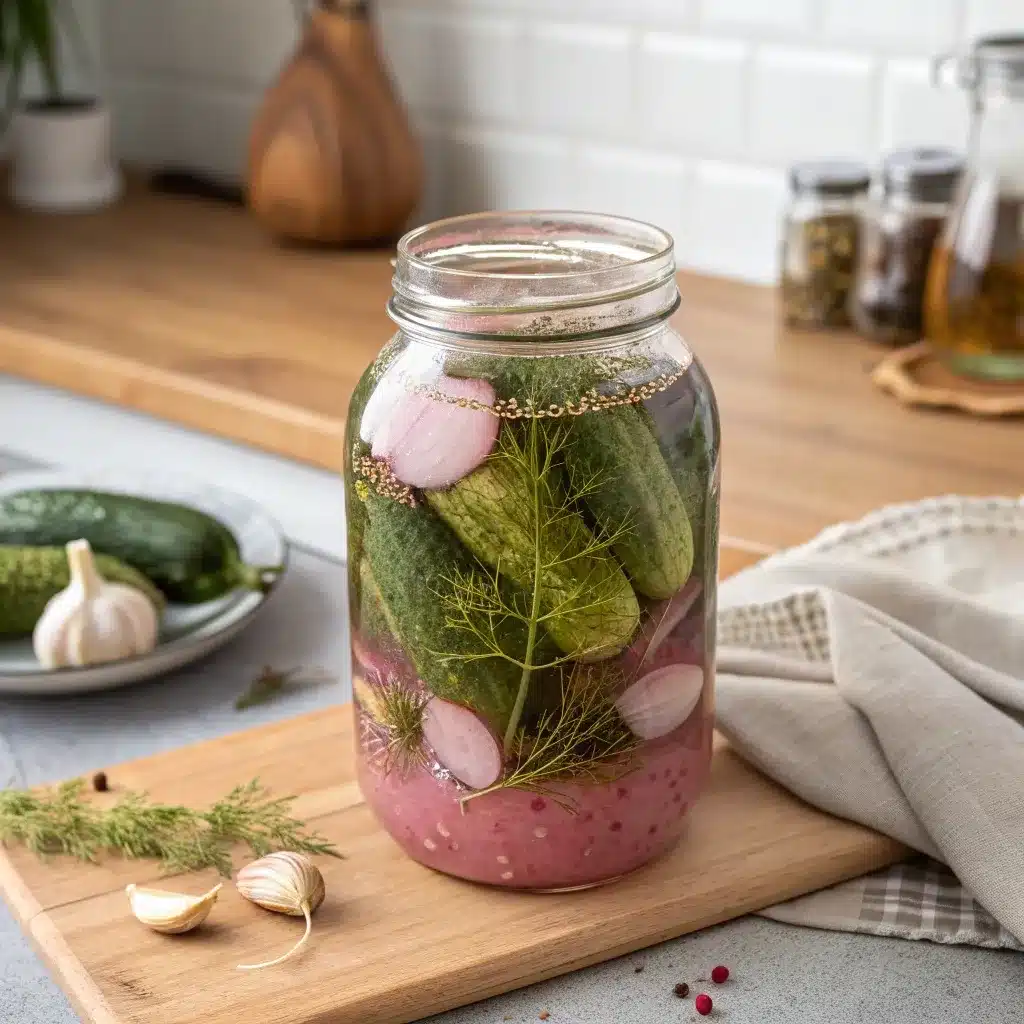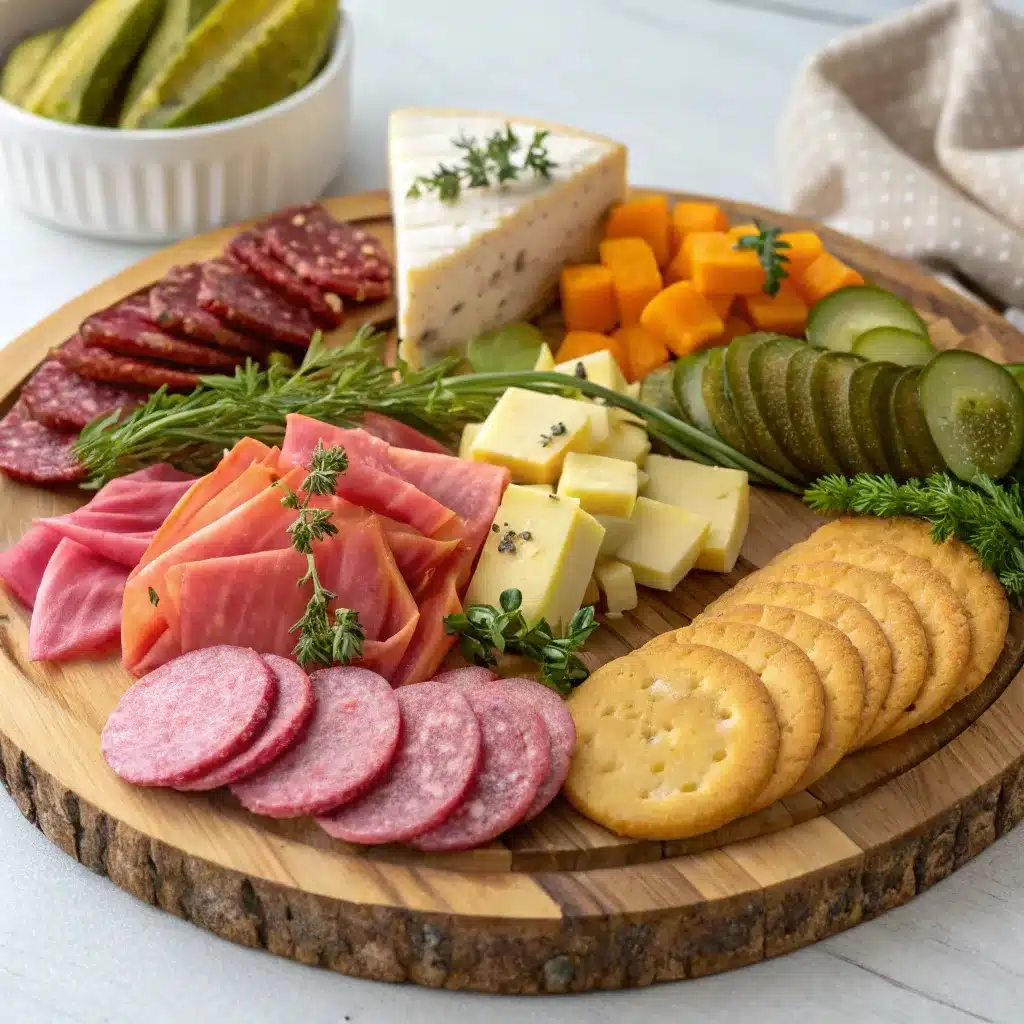Introduction
If you’ve ever bitten into a pickle that snapped with the perfect crunch, you know just how satisfying that bite can be. This pink salt pickles recipe takes that experience up a notch by using Himalayan pink salt in the brine. I first tried this twist on a late-summer afternoon when I had an abundance of cucumbers from the garden and a small jar of pink salt on the counter. The result was unforgettable: crisper texture, tangier flavor, and a depth I’d never noticed in ordinary pickles.
What makes this recipe so special is the way pink salt works in the brine. It doesn’t just season the cucumbers—it enhances them, preserving their bite and adding subtle layers of flavor. Whether you’re preparing crunchy spears for sandwiches or thin slices for burgers, pink salt pickles offer a refreshing upgrade to the classics.

Pink salt has already made a name for itself in other recipes, like the Pink Salt Trick, where a small pinch can transform the flavor of sweet or savory dishes. In pickling, though, it goes beyond flavor—it helps maintain crispness and creates a brine that feels balanced instead of sharp. That’s why this pink salt pickles recipe has become a staple in my kitchen, especially when I want to share something unique yet approachable with family and friends.
Table of Contents
Why Use Pink Salt in Pickles?
Minerals & Flavor Benefits
The first reason to reach for pink salt in your brine is taste. Regular table salt gives you sharp saltiness, but pink salt provides a gentler, rounder flavor. This comes from its mineral content, which can include small amounts of calcium, potassium, and magnesium. While the amounts are tiny, they lend a slight earthiness that makes pickled vegetables taste fuller and less flat.
When you make a Himalayan pink salt pickles recipe, the flavor is noticeably more layered. Instead of salt dominating, the cucumbers, garlic, and dill shine through, all lifted by the pink salt’s subtle touch. For anyone who enjoys gourmet twists on everyday foods, this simple swap feels like a big upgrade.
Crunch Factor in Pickling
Flavor is one thing, but the real magic of pink salt in pickles is texture. Nobody likes a limp pickle. The minerals in pink salt contribute to a brine that helps vegetables hold their firmness during fermentation or quick pickling. It’s the reason many home canners notice their pink salt pickles stay crisp longer than those made with standard table salt.
This is also why pink salt shows up in other recipes where crispness matters. Just as it helps vegetables stay snappy in brine, it helps create golden, crunchy edges in dishes like Crispy Roasted Potatoes with Pink Salt. Both are great examples of how pink salt does more than season—it transforms the final texture.
With these benefits in mind, it’s easy to see why using Himalayan salt for pickles has gained popularity. It’s not just about the pretty pink crystals—it’s about flavor that lingers and crunch that lasts.
Print
Pink Salt Pickles Recipe
- Total Time: ~25 minutes active + fermentation
- Yield: 3–4 jars (pint size) 1x
Description
Crunchy, tangy homemade pickles made with Himalayan pink salt for a balanced brine and superior texture. This pink salt pickles recipe is easy, reliable, and endlessly customizable.
Ingredients
- 2 lbs pickling cucumbers (washed and trimmed)
- 3 cups water (filtered)
- 2 cups white vinegar (or apple cider vinegar)
- 1 cup Himalayan pink salt
- 6 garlic cloves, peeled
- 6 sprigs fresh dill
- 2 tsp mustard seeds (optional)
- 1 tsp peppercorns (optional)
- 1 tsp red chili flakes (optional for spicy variation)
- 2 tbsp sugar or honey (optional for sweet variation)
Instructions
- Wash cucumbers and cut into spears, slices, or leave whole.
- In a saucepan, combine water, vinegar, and pink salt. Simmer until salt dissolves. Let cool slightly.
- In sterilized jars, layer garlic, dill, and spices. Pack cucumbers tightly, leaving ½ inch headspace.
- Pour brine over cucumbers, ensuring they are fully submerged.
- Seal jars. For quick pickles, refrigerate for at least 24 hours before eating. For fermented pickles, leave at room temperature 4–5 days until bubbly, then refrigerate.
- Enjoy within 2 months for best flavor and crunch.
Notes
- Always measure pink salt by weight for accuracy.
- Keep vegetables submerged under brine to prevent spoilage.
- Try carrots, radishes, or cauliflower for variety.
- Prep Time: 20 minutes
- Fermentation Time: 1–5 days
- Category: Preserving
- Method: Pickling / Fermentation
- Cuisine: Global
Nutrition
- Serving Size: per 1 spear
- Calories: 8 kcal
- Sugar: 0.5 g
- Sodium: 260 mg
- Fat: 0 g
- Saturated Fat: 0 g
- Carbohydrates: 2 g
- Fiber: 0.5 g
- Protein: 0.3 g
- Cholesterol: 0 mg
Ingredients for Pink Salt Pickles
Making this pink salt pickles recipe doesn’t require anything complicated—just a handful of everyday ingredients. What makes it special isn’t the number of ingredients, but the choice of salt. Himalayan pink salt changes the entire brine, giving you pickles that are not only flavorful but also satisfyingly crisp.

The Essential Ingredients
Here’s what you’ll need to prepare a batch of crunchy, tangy pickles:
- Cucumbers: Pickling cucumbers (Kirby or Persian) are best because of their firm texture and smaller size.
- Himalayan Pink Salt: The star of the recipe. Unlike table salt, pink salt provides a more balanced brine that preserves crunch.
- Water: Filtered water is best to avoid chlorine, which can soften the vegetables.
- Vinegar: White vinegar or apple cider vinegar for tang and preservation.
- Garlic: Adds bold, aromatic notes.
- Dill: Fresh dill sprigs bring classic pickle flavor.
- Optional Spices: Mustard seeds, peppercorns, or red chili flakes for variety.
Using pink salt here is more than a novelty. Its mineral composition means the brine feels smoother and more rounded. When combined with vinegar and herbs, the result is a brine that elevates simple cucumbers into something worth savoring.
Choosing Vegetables Beyond Cucumbers
Although cucumbers are traditional, this pink salt pickles recipe works beautifully with other vegetables too. Carrots, radishes, cauliflower, and even green beans all benefit from the salty-tangy balance of a pink salt brine. Each vegetable takes on its own personality while still carrying that addictive crunch.
This versatility is why I often keep a jar of pink salt brine ready to experiment with whatever vegetables are in season. In fall, for example, I pair it with root vegetables, while in spring I turn to crisp radishes. If you’re into seasonal eating, you’ll find it pairs perfectly with other wholesome recipes, like Pumpkin Baked Oatmeal with Oat Flour, which celebrates cozy, nourishing flavors in a very different way.
The best part is that once you master the brine, you can apply this method to countless vegetables. This flexibility makes pink salt pickles more than a one-time experiment—they become a tool in your kitchen for adding brightness and crunch to everyday meals.
Step-by-Step Recipe Method
Pickling can seem intimidating at first, but once you understand the process, it’s straightforward and rewarding. With this pink salt pickles recipe, the goal is simple: crisp, tangy vegetables that last in the fridge and taste better every day they sit in brine. Let’s walk through each step in detail.
Preparing the Cucumbers
Start by choosing firm cucumbers with no soft spots. Wash them well, trim the ends, and decide how you want to cut them—spears for sandwiches, slices for burgers, or leave them whole for a classic jar pickle. Cutting them evenly helps ensure every piece absorbs brine at the same rate.
If you’re experimenting with other vegetables, such as carrots or cauliflower, prep them in the same way: wash thoroughly and cut into uniform pieces. This will give you pickles that look neat in the jar and taste consistently seasoned.
Making the Pink Salt Brine
The brine is the foundation of this pink salt pickles recipe. It’s made with water, vinegar, and Himalayan pink salt. A common ratio is two cups of water, one cup of vinegar, and three tablespoons of pink salt—similar to the “3-2-1 rule” often used in pickling. This formula strikes the perfect balance between salty, tangy, and flavorful.
Bring the water and vinegar to a simmer, then stir in the pink salt until it dissolves completely. This step is critical—undissolved salt can leave gritty spots in your pickles. Once dissolved, let the brine cool slightly before pouring it over the vegetables.
Packing the Jars
In each clean glass jar, place a few garlic cloves and dill sprigs at the bottom. Add the cucumbers (or other vegetables), packing them tightly but leaving about half an inch of headspace at the top. Tuck in spices like mustard seeds or peppercorns if you want an extra layer of flavor.

Pour the warm pink salt brine over the vegetables until they’re fully submerged. A good trick is to place a small piece of cabbage leaf or a glass weight on top to keep everything below the brine line. Exposure to air can cause spoilage, so this step ensures a safe, flavorful ferment.
Quick Pickles vs Fermented Pickles
One of the great things about this pink salt pickles recipe is flexibility. If you want quick pickles, simply cover the jars and refrigerate them. They’ll be ready to enjoy in as little as 24 hours, though the flavor deepens after three to four days. Quick pickles are perfect if you’re making a small batch for immediate use.

For a more traditional fermented pickle, leave the jars at room temperature for several days. During this time, natural bacteria convert sugars into lactic acid, giving the pickles a deeper tang and a probiotic boost. You’ll notice bubbles forming in the brine—a sign fermentation is working. After about five days, move the jars to the refrigerator to slow the process.
A Flavorful Kitchen Companion
Once you master this process, you’ll find jars of pink salt pickles are a natural fit alongside many meals. They’re the crunchy partner to grilled meats, the zesty topping for burgers, and the tangy snack you didn’t know you needed. The pink salt brine adds a depth that makes them taste gourmet without complicating the process.
In fact, they complement homemade sauces beautifully. Imagine serving your pink salt pickles next to grilled chicken brushed with Huli Huli Sauce. The sweet, savory sauce paired with tangy, salty pickles is the kind of contrast that makes a meal unforgettable.
With these steps, you can confidently prepare a batch of pickles that stays crisp, tangy, and flavorful. This isn’t just a recipe—it’s a foundation for experimenting with vegetables, herbs, and spices, all made better by the power of pink salt.
Flavor Variations for Pink Salt Pickles
One of the best things about this pink salt pickles recipe is that once you’ve learned the basic brine, you can customize it in countless ways. Whether you like your pickles fiery, a little sweet, or packed with herbs, pink salt adapts beautifully and keeps every version crisp and flavorful.
Spicy Pink Salt Pickles
For heat lovers, spicy pickles are a must. Add sliced jalapeños, red chili flakes, or even whole dried chilies to the jar before pouring in the pink salt brine. The spiciness infuses the cucumbers while balancing perfectly with the salty-tangy flavor. Over a few days, the heat deepens, making these pickles perfect for sandwiches, tacos, or even as a bold snack straight from the jar.
The beauty of using pink salt in this version is that it rounds out the spice, preventing the heat from overwhelming the palate. Each bite has layers of flavor—salty, tangy, and spicy all at once.
Sweet & Tangy Pickles
If you prefer a milder pickle, try adding a tablespoon of sugar or honey to the brine before it cools. This creates a subtle sweetness that balances the vinegar’s sharpness and complements the pink salt beautifully. Sweet and tangy pickles are especially popular for burgers, fried chicken sandwiches, or charcuterie boards, where they add contrast to richer foods.
The minerals in pink salt help mellow the sweetness, so the pickles taste vibrant without being cloying. It’s a small tweak that makes your pink salt pickles recipe versatile for both savory and sweet-leaning dishes.
Garlic-Dill Classics with Pink Salt
Of course, nothing beats the classic garlic-dill combination. Fresh dill sprigs and a few cloves of garlic in each jar transform simple cucumbers into old-fashioned favorites. What makes this version shine is the pink salt brine, which helps preserve the bright dill flavor while enhancing the garlic’s pungency.
These pickles are the ultimate everyday choice: crunchy, aromatic, and packed with familiar flavor. They’re fantastic on burgers, served with roasted meats, or paired with fresh salads like Sbarro Cucumber Tomato Salad, where the tangy pickles add contrast to the fresh vegetables.
Experimenting with these variations is part of the fun. You’ll find that no matter which direction you take, the pink salt pickles recipe provides the foundation for crisp, flavorful results every time.
Serving Ideas for Pink Salt Pickles
Pickles are one of those foods that slip effortlessly into countless meals, and this pink salt pickles recipe makes them even more versatile. Their crisp texture and tangy bite can brighten a simple dish or become the star of a snack platter.

Everyday Uses
The most obvious way to enjoy pink salt pickles is on sandwiches and burgers. A crunchy spear or a few tangy slices can transform a basic meal into something bolder and more satisfying. They’re also fantastic alongside grilled meats, adding balance to rich flavors with their salty-tangy kick.
Tacos and wraps are another smart use. Chopped pink salt pickles give fish tacos a zing or add brightness to pulled pork wraps. And if you’re a fan of homemade deli platters, no charcuterie board is complete without a jar of crunchy pickles ready to cut through the richness of cheeses and cured meats.
Entertaining with Pickles
For parties, pink salt pickles make an easy crowd-pleaser. Arrange them on a platter next to cheeses, crackers, and meats for a balanced appetizer spread. The salty crunch keeps guests reaching for more, especially when paired with savory bites like Garlic Bread Ritz Bits. The soft, cheesy bread pairs beautifully with tangy pickles, creating a combination that’s both playful and satisfying.
Pickles also shine at outdoor gatherings. Pack jars of spears for picnics or barbecues, where they serve as refreshing palate cleansers between grilled dishes. Their portability and long shelf life make them one of the easiest homemade treats to share.
From casual weeknight meals to holiday spreads, this pink salt pickles recipe proves that a jar of pickles can be more than just a side dish—it’s a versatile ingredient that adds crunch, brightness, and balance wherever it goes.
FAQs About Pink Salt Pickles
Can you make pickles with pink salt?
Yes, you can absolutely make pickles with pink salt, and many people prefer it over table salt or even kosher salt. The minerals in pink salt give the brine a subtle complexity that makes the flavor more layered. It also helps vegetables stay firmer during fermentation, which is why this pink salt pickles recipe delivers such a satisfying crunch. Some recipes call for pickling salt specifically, but pink salt works just as well when dissolved properly. For a deeper look at how a pinch of pink salt can transform everyday dishes, check out the Pink Salt Trick Recipe.
What is the 3 2 1 rule for pickling?
The 3-2-1 rule is a simple ratio that makes pickling easy to remember: three parts water, two parts vinegar, and one part salt. For this pink salt pickles recipe, that translates to 3 cups of water, 2 cups of vinegar, and 1 cup of Himalayan pink salt (though smaller batches can be scaled down). This formula gives a balanced brine that’s salty, tangy, and effective for preserving vegetables. It’s a helpful rule for beginners and can be adjusted depending on whether you want a sharper or milder pickle.
What are the three ingredients in the pink salt trick?
The “pink salt trick” is a kitchen shortcut that combines Himalayan pink salt with simple everyday ingredients to boost flavor. While the exact application varies, the essentials are: pink salt, a base ingredient (like potatoes, chocolate, or cucumbers), and a cooking method (roasting, caramelizing, or brining). In this pink salt pickles recipe, the three-star ingredients are cucumbers, pink salt, and brine, working together to create crunch and balance.
Can I use pink salt instead of kosher salt?
Yes, you can substitute pink salt for kosher salt in most pickle recipes, including this one. Both salts are free from additives, but pink salt has trace minerals that slightly alter the flavor of the brine. The difference is subtle but noticeable—pickles made with pink salt taste more rounded and complex. Just remember to measure by weight, not volume, since salt crystals vary in size. This adjustment ensures your pink salt pickles stay perfectly balanced.
Is pink salt healthier than kosher salt?
Pink salt isn’t “healthier” in the sense of being lower in sodium, but it does contain trace minerals like calcium and magnesium. These minerals don’t make a dramatic nutritional difference, but they do contribute to flavor. For health-conscious eaters, the real benefit of using Himalayan pink salt is that it’s less processed than table salt. In the context of this pink salt pickles recipe, the appeal is mostly flavor and texture—pickles stay crunchy and taste more complex than when made with kosher salt.
What can you substitute for pickling salt?
If you don’t have pickling salt on hand, pink salt is one of the best alternatives. Kosher salt and sea salt also work, though they may leave the brine slightly cloudy. Avoid table salt, since additives can affect the clarity and taste of the brine. This pink salt pickles recipe shows just how well pink salt performs in place of pickling salt, giving you crisp, tangy vegetables without compromise.
Conclusion
At the end of the day, what makes this pink salt pickles recipe so special is its simplicity and effectiveness. With nothing more than cucumbers, vinegar, water, and Himalayan pink salt, you can create jars of crisp, tangy pickles that taste far better than anything you’ll find on store shelves.
Pink salt does more than season—it enhances texture, draws out freshness, and keeps pickles crunchy long after they’ve been jarred. Whether you enjoy them as a snack, pile them onto burgers, or set them out on a holiday spread, these pink salt pickles are guaranteed to disappear fast.
If you’ve enjoyed this recipe, don’t stop here. Explore other creative uses of pink salt, like the indulgent Pink Salt Caramel Sauce, to see how this simple ingredient can transform both savory and sweet dishes. With a little practice, pink salt will become one of the most versatile tools in your kitchen.
So grab your cucumbers, make a batch, and discover why this pink salt pickles recipe deserves a permanent spot in your fridge.